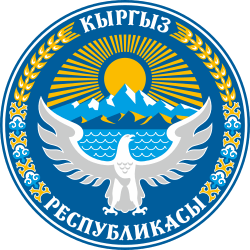Flag of Kyrgyzstan
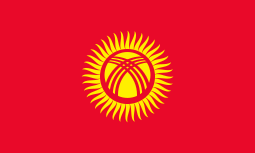 | |
| Use | Civil and state flag, national ensign |
|---|---|
| Proportion | 3:5 |
| Adopted | March 3, 1992 |
| Design | A red field charged with a yellow sun with forty uniformly spaced rays; the sun is crossed by two sets of three lines |
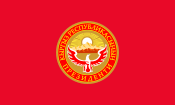 Variant flag of Kyrgyz Republic | |
| Use | Presidential Standard |
| Proportion | 3:5 |
| Design | A red field charged with the Emblem of the President of Kyrgyzstan in the centre |
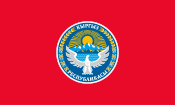 Variant flag of Kyrgyz Republic | |
| Use | Government flag |
| Proportion | 3:5 |
| Adopted | Since 2017 |
| Design | A red field charged with the national emblem in the centre |
The flag of Kyrgyzstan consists of a red field charged with a yellow sun that contains a depiction of a yurt (traditional tent). It is actually a depiction of the first thing one sees when waking up in a yurt, namely the construction of the pinnacle of every Kyrgyz yurt with three crisscrossing laths across the circular opening at the top of the yurt. Adopted in 1992, just over seven months after the country's independence was declared, to replace the flag of the Kirghiz Soviet Socialist Republic (SSR), it has been the flag of the Kyrgyz Republic since that year. Although the colour of the flag is identical to the former Soviet flag, the red is said to be inspired by the pennant lifted by Manas, the country's folk hero.
History
Under Soviet rule, the Union Republic – coterminous with modern-day Kyrgyzstan – utilized a flag derived from the flag of the Soviet Union and representing Communism, that was adopted in 1953.[1] It declared itself independent on August 31, 1991, approximately four months before the dissolution of the Soviet Union.[2] Nevertheless, the Soviet-era flag maintained its status as the national flag for seven months after independence was declared.[1] It was finally replaced by the new design on March 3, 1992.[1][3]
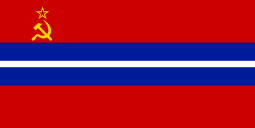 Flag of Kirghiz SSR or Kirghizia from 1952 to 1991.
Flag of Kirghiz SSR or Kirghizia from 1952 to 1991..svg.png) Flag of independent Kyrgyzstan between independence from the USSR and adoption of the current flag
Flag of independent Kyrgyzstan between independence from the USSR and adoption of the current flag
Design
Symbolism

The colors and symbols of the flag carry cultural, political, and regional meanings. The red field stands for "bravery and valor",[2] and alludes to the purported emblem hoisted by Manas, the national hero of Kyrgyzstan.[1][4] The sun epitomizes peace and prosperity,[2] while its 40 rays stand for the number of tribes united by Manas to fight against the Mongols,[4][5] as well as the number of followers he had.[1][3]
The centre of the sun features a stylized illustration of the roof (tunduk) atop a traditional Kyrgyz tent (yurt) when viewed from the interior.[1][3][6] Although these tents are less commonly used today,[1] its incorporation into the flag is meant to symbolize the "origin of life", the "unity of time and space", as well as the people's "hearth and home" and their history.[1][3]
Proposals to change
In recent years, a commission was established to examine proposals to modify the design of the flag. The head of this body observed how it was the object of conflict and disunity, and that the government did not want this national symbol to be the cause of further division in society. This partially stemmed from disagreement over the interpretation of the symbols on the current flag.[7] For instance, modern-day Kyrgyzstan is ethnically diverse, with sizeable minority groups such as the Uzbeks (14.3%) and Dungans (1.1%) living there.[2] These groups were historically conquered by Manas, and hence, the current flag – inspired by his emblem utilized in war – does not sit well with some of them.[7]
The red field has also been the source of much criticism. Some believe that it evokes the nation's tempestuous history, while others are of the opinion that it is a lingering remnant of communism in the country.[7]
Regional flags
Each region (областы, oblasty or облусу, oblusu) of Kyrgyzstan has its own flag.

 Bishkek (independent city)
Bishkek (independent city)





See also
- Flag of the Kirghiz SSR
- Importance of forty among Turkic people
References
- 1 2 3 4 5 6 7 8 Smith, Whitney (February 9, 2001). "Flag of Kyrgyzstan". Encyclopedia Britannica. Encyclopedia Britannica, Inc. Retrieved March 23, 2017.
- 1 2 3 4 "Kyrgyzstan". The World Factbook. CIA. Retrieved March 23, 2017.
- 1 2 3 4 Kindersley, Dorling (November 3, 2008). Complete Flags of the World. Dorling Kindersley Ltd. p. 194. Retrieved March 23, 2017.
- 1 2 World and Its Peoples, Volume 1. Marshall Cavendish. September 1, 2006. p. 629. Retrieved March 23, 2017.
- ↑ Omelicheva, Mariya Y., ed. (December 17, 2014). Nationalism and Identity Construction in Central Asia: Dimensions, Dynamics, and Directions. Lexington Books. p. xviii. Retrieved March 23, 2017.
- ↑ Peoples of Western Asia. Marshall Cavendish. September 1, 2006. p. 254. Retrieved March 23, 2017.
- 1 2 3 Namatbaeva, Tolkun (March 9, 2012). "Fight rages over Kyrgyzstan's flag". The Washington Times. Archived from the original on March 23, 2017. Retrieved March 23, 2017.
External links
| Wikimedia Commons has media related to Flags of Kyrgyzstan. |
